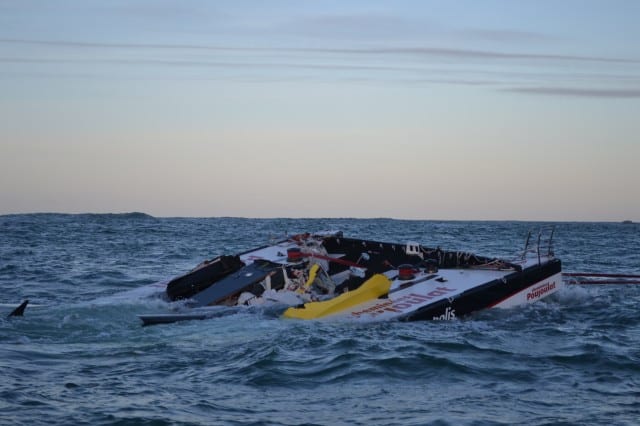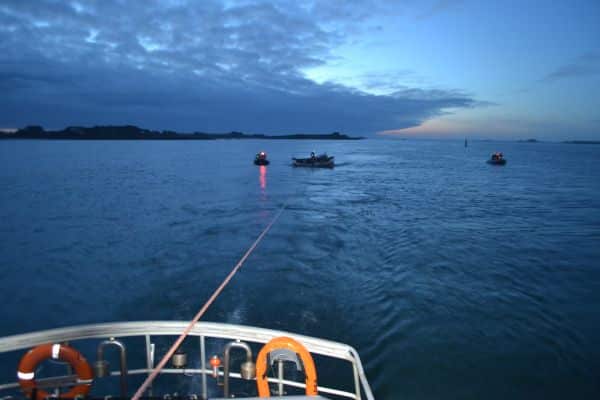The news was not good: Cheminées Poujoulat, with Bernard Stamm and Damien Guillou onboard, was in serious trouble 180 miles from shore as one of the worst storms in decades pounded the Brittany Coast. For those onshore in the safety of their homes during that dark night before Christmas Eve, it was hard to imagine what it would be like to call a mayday as 70-knot winds and 20-foot waves struck the rocky coast.
Many shook their heads and said both sailors had known what to expect and lost after rolling the dice, instead of avoiding the storm. This type of reaction is common among those in the tight-knit offshore sailing and commercial fishing industry. When bad things happen, people often say something like: “They were professionals and knew the risks.”
But things were not what they seemed to be in many ways. To begin with, Stamm and Guillou are world-class offshore sailors. More importantly, the sea conditions were not as bad where they were over 150 miles off the coast. Indeed, why Cheminées Poujoulat split in two still remains a mystery over a month later. The incident is especially puzzling considering how the design of the Vendée Globe’s IMOCA class boats are supposed to be significantly safer and sturdier than they were a decade ago.
“Something like this has never happened before in the history of the IMOCA class,” said Merfyn Owen, of Owen Clarke Design, which designed Acciona.

Bernard Stamm
The two sailors were on their way from Brazil when disaster struck, after taking third place in the IMOCA class category of the Transat Jacques Vabre. Stamm had successfully skippered Cheminées Poujoulat alone for most of the Vendée Globe course less than a year before without experiencing any major structural breakage, but was forced to abandon the race south of New Zealand due to a hydrogenerator malfunction.
Both sailors had also seen worse, much worse, and as Stamm would later reveal, they had avoided the nastiest part of the storm. They were taking their time when the incident happened, sailing at 12 to 13 knots with four reefs and the wind behind them. The wind was gale force, between 43 and 45 knots, and the seas were big, but the main part of the front was ahead of them.
“You don’t prepare to sail around the world in only 15 knots of wind in Brittany,” Stamm said. “We never felt like we had to shut everything down and go inside, which you have to do if the conditions get too bad.”
In short, the two sailors thought they were in good shape to head to port the next morning on a tried-and-tested boat sailing well within the limits for which it was designed. But that all changed at around 8:30 p.m. The two sailors were seated at the map table when they heard a loud crack as the boat went over a wave.
Guillou climbed out of the cabin onto the deck and at first thought they had dismasted. But it quickly became apparent that the unthinkable had happened: The boat had broken in two, with most of the back of the cockpit hanging to the rest of the boat by a few cables. They immediately closed the cockpit hatch to prevent what was left of the boat from sinking and radioed for help.
It was very hit or miss during the following 8 to 10 hours. A helicopter from England found them and instructed the sailors by radio to board their life raft and prepare for an airlift rescue. The two men put the lifeboat in the water but could not swim through the pounding and cresting waves to reach it. When they swam back with their lifelines still attached, they had trouble pulling themselves back onto the boat. They finally managed to pull themselves onboard between wave crests that pounded them against the boat. In the process of abandoning the life raft, they lost their satellite phone, emergency water, fuses, and other survival gear.
They finally managed to pull themselves onboard between wave crests that pounded them against the boat.
A plane later flew over them and airdropped five life rafts on top of what was left of the boat, but they were only able to recover one of them. “It was dark and we could not see anything,” Stamm said. “The sea conditions were very rough.”
A Norwegian container ship arrived a few hours later and maneuvered so that the wrecked Cheminées Poujoulat touched its side. The rescue attempt was risky, but the ship’s cargo capacity was almost full, which weighted it down in the water. Otherwise, the ship could have crushed what was left of Cheminées Poujoulat into pieces with the two men onboard as the ship rose and fell with the large and confused waves. Still, at one point, Cheminées Poujoulat drifted near the boat’s hull and was pounded against the side, causing it to break up even more.
After several failed attempts, Stamm finally managed to tie himself to a rope the cargo ship crew had thrown down and was pulled up to safety. “It was really a last-minute thing because the boat was starting to sink,” Stamm said. “At the end of the rescue, the wind was starting to blow again and we started to get cold.”
But once on deck on the container ship, Stamm suffered his worst fright yet. “All I could think about was that I had left Damien behind,” Stamm later recounted. “I screamed at the crewmembers, telling them they had to rescue Damien as well, and they told me not to worry.”
It was widely reported that Cheminées Poujoulat had sunk and that the two sailors were rescued in just the nick of time. But about two weeks later, a French customs patrol boat found the wreck of Cheminées Poujoulat floating off the French island of Vierge. The boat, mostly submerged, was barely intact, while the back deck remained attached by cables. “Needless to say, I was surprised to see Cheminées Poujoulat after I witnessed it sinking,” Stamm said. “Maybe the boat reached the surface again after the keel fell off.”
“Needless to say, I was surprised to see Cheminées Poujoulat after I witnessed it sinking.”
We may never learn why Cheminées Poujoulat, which remains tied up and half-submerged at the port of Aberwrach, France, cracked up (watch video here).
“We will know more once Cheminées Poujoulat is taken out of the water,” he said. “But you have to remember that a large chunk of the boat is missing.”
So what does this incident mean for the IMOCA class, following the number of keel and other breakages during the last Vendée Globe?
“What I would say is that I believe the IMOCA structure and safety record speaks for itself,” Owen says. “Our greatest problems in the past ten years have been rigs and keels. The new rules have addressed this even if the solution is not to everyone’s satisfaction.”

Cheminees Poujoulat










